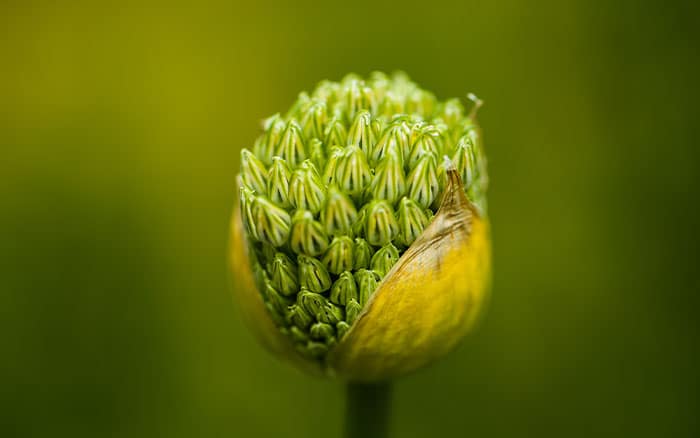There’s something almost magical about the globe-like blooms of alliums, hovering like fireworks above the border. But what happens when your allium plants invest in forming a bud, only for it to never open?
I’ve seen this frustrating scenario time and time again. Unlike a bulb, which never blooms, this issue indicates the plant wants to flower. However, something is stopping it.
From water imbalance to nutrient slip-ups, and even stealthy pests, the reasons are rooted deep in plant science. Here’s what might be happening, and what you can do to coax your reluctant buds to open.
1 – Water stress at the wrong time
Alliums are famously drought-tolerant once established, but this reputation can be misleading during bud formation.

Scientific insight:
Petal expansion depends heavily on hydrostatic (turgor) pressure. When water is scarce, cell elongation slows down, preventing the physical opening of the bud. Studies now confirm that water-deficit conditions impair the separation of floral tissues in allium species.
What to do:
- Water deeply in April and May, when buds are forming.
- Apply organic mulch around the base to conserve moisture but keep it off the stems to avoid rot.
Pro tip: If your soil is sandy or free-draining, it loses moisture rapidly. Consider digging in organic matter in autumn to improve retention.
2 – Nutrient imbalance – too much nitrogen, not enough potassium
If you have lush leaves but buds are sealed, chances are your plants have been fed with too much nitrogen. This often happens amongst gardeners, and is easily amended.
Scientific Insight:
Potassium is key in osmotic regulation and sugar transport. This directly influences the energy available in developing flower tissues. Too much nitrogen increases foliage growth at the expense of floral development. Then, hormone signalling is distorted.
What to Do:
- Avoid high-nitrogen feeds after early spring leaf growth.
- Switch to a high-potash fertiliser like tomato feed or liquid seaweed every 10–14 days once flower stems emerge.

3 – Temperature shock or late frost
Despite being hardy, allium flower buds are vulnerable to unexpected cold snaps in late spring. A sudden frost after bud formation can damage the floral tissues before they get the chance to open.

Scientific Insight:
Even a brief dip to 2–3°C can trigger ‘protein denaturation’ in meristematic (growing) cells. This is where proteins in the growing parts of the flower lose their shape and stop working. Ultimately, this “freezes” development in place.
What to Do:
- Cover emerging buds with horticultural fleece if frost is forecast in April or May.
- Grow alliums in a sunny, sheltered spot with southern or western exposure.
4 – Stuck in the spathe – a mechanical obstruction
Sometimes, the papery sheath (Spathe) around the bud becomes tough or dry. Especially in mature plants or during prolonged dry spells. This can physically trap the flower inside.
What to Do:
- Lightly mist the bud in the morning to soften the spathe.
- In stubborn cases, gently peel or snip it open using sterilised scissors. But only as a last resort.

5 – Pests

It’s uncommon, but sometimes tiny sap-sucking pests like thrips get inside the bud. They cause the florets to dry out or become misshapen, the bud remaining stubbornly closed.
What to Do:
- Inspect for silver streaks, tiny black specks (frass), or any distortion.
- Treat early in the day with horticultural soap.
Summary: Quick troubleshooting guide
| Symptom | Likely Cause | What to do |
|---|---|---|
| Bud formed but didn’t open | Water stress | Deep water & mulch |
| Lush foliage, closed bud | Too much nitrogen | Feed with high-potash food |
| Bud browns or shrivels | Frost damage | Cover with fleece |
| Bud stuck in sheath | Dry weather or age | Mist or gently peel |
| Distorted or scarred bud | Insect damage | Inspect and treat early |
A hesitant allium bud signals something’s off. With good timing, insight, and care, you can help it bloom, whether for show or simple garden beauty.
For more great gardening advice, make sure you head to my YouTube Channel. Make sure you’re subscribed with notifications on so you don’t miss any of my new videos.
Frequently Asked Questions
1 – Why did my allium form a bud but never a flower?
This usually means the plant intended to bloom but was interrupted. Common causes include water stress during bud formation, too much nitrogen in the soil, frost damage, or mechanical issues like a dry spathe trapping the bloom.
2 – How should I water alliums to avoid bud failure?
Water deeply in April and May, when flower buds are forming. Alliums are drought-tolerant later, but early water stress affects turgor pressure, which prevents the bud from opening properly.
3 – Can cold weather stop allium buds from opening?
Yes. A brief dip to 2–3°C can damage the growing cells in the flower bud. This stops development in its tracks. Protect emerging buds with horticultural fleece during spring frosts.
4 – How can I tell if nutrient imbalance is stopping allium buds from opening?
If your plant has lush green leaves but unopened buds, it may have had too much nitrogen. This stimulates foliage over flowers. Switch to a high-potash feed like liquid seaweed once stems emerge.
5 – What should I do if the allium bud is stuck in its sheath (spathe)?
Try mist-spraying the bud in the morning to soften the spathe. In dry weather or with older plants, you may need to carefully snip the sheath using sterilised scissors, but only as a last resort.

Leave A Comment